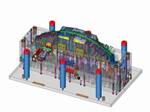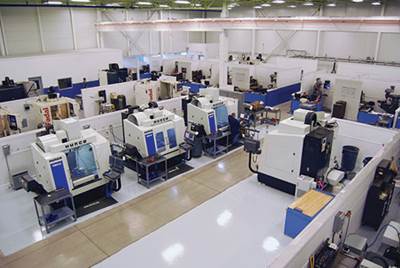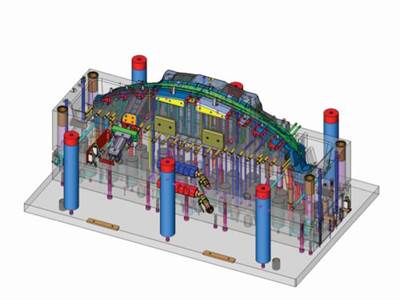Integrated Software Speeds End-to-End Moldmaking Operations
Cimatron CAD/CAM software from 3D Systems helped PTI Engineered Plastics simplify the flow of its work from design to production.
PTI Engineered Plastics offers high-volume manufacturing of molds for the medical and automotive industries, with a focus on advanced product development and innovative manufacturing solutions. But it wasn’t always the streamlined operation it is today. Cimatron CAD/CAM software from 3D Systems helped the company simplify the flow of work from “end to end,” or from design to production.
Founded in 1984, PTI started out in product development, prototyping and low-volume manufacturing. Over the past 30+ years, the company added higher volume manufacturing capabilities, including building highly detailed production molds ranging from single-cavity to eight cavities, and between 12 and 750 tons. All services are delivered by a team of 300 employees in a state-of-the-art, 155,000-square-foot facility in Macomb, Michigan.
For many years, the shop built tools the “old-fashioned way,” meaning PTI’s staff of journeymen moldmakers each performed 90 percent of the mold designing and building, from start to finish, says Christopher Behring, tooling operations manager. The company decided to departmentalize operations in 2008, so that the main functions in the entire moldmaking process, from end to end, were handled by different “departments,” not by a single person. In order to do this efficiently and effectively, PTI needed a software solution that would streamline the flow of work from department to department and further advance each department’s capabilities. The shop had been using Cimatron for a number of years for some designing, cutting and electrode work, but it quickly realized that it was not using the software to its fullest potential. Cimatron ultimately helped the shop realize improvements in quoting accuracy, mold design and machining, and electrode placement and EDM.
Quoting Accuracy
Before Cimatron, estimating was a much slower process for PTI, Behring says. Designers had to make many assumptions, and requested changes were difficult to communicate. Manufacturing issues were not easy to anticipate and usually were not discovered until the mold build was in process. Cimatron helped to simplify the quoting process by providing a way to quickly analyze parts for manufacturability.
“Now we do a mini DFM [design for manufacturing] on every job using Cimatron’s QuickSplit feature, which, by literally splitting the part design, allows us to see and highlight points of concern on screen,” he explains. “We can quickly address any issues during the quoting stage and fix them using the QuickCompare feature, or properly cost it out, depending on the job requirements. It also allows us to mock up or alter models quickly for customers to view. What used to take hours or days now takes minutes.”
In general, the software enables PTI to produce quotes faster and more accurately, providing better results while using fewer resources. For example, during the quoting phase of a recent build of a mold for a medical device housing, Behring says his team used the QuickSplit feature to quickly see that draft was not enough for the texture specified in the part design. Also, 12 clips and three windows needed to be created from telescoping shutoffs, but the design allotted zero degrees for these shutoffs. “We were able to identify the trouble areas, make adjustments to the data so the customer could better understand the problem and supply quotes based on better tooling practices,” Behring says. “Our customers like this because it eliminates work for them, and the scope of the job is 100-percent understood before any steel has been cut.”
Mold Design and Machining
In addition to helping to improve quoting accuracy, the software helps improve the overall mold design and build process. Cimatron’s Mold Design function integrates the entire mold design process, from translation of standard CAD data files to tool modeling and assembly, part modification, and more, and still offers the flexibility needed for last-minute changes.
Previously, PTI’s design team used three different software programs and designed wire-frame models, but this process created bottlenecks later in production due to machine language translation issues. “We build more than 700 molds per year, and having to translate and refile dozens of steps for each process on each mold cost us a tremendous amount of wasted time,” Behring explains. “And that doesn’t count time for design changes or corrections that further delayed completion.” The fact that Cimatron eliminated the need for file translation between processes is one of the reasons PTI chose it over other software packages.
The software’s NC Programming function also has enabled the shop to streamline its machining timetables. With jobs designed in wire-frame models or 2D plots, the CNC programmer would have to take the design in whichever format he had received it and more or less finish the model before he could move forward with machining. NC Programming enables designers to develop machine-ready models for specific tasks, including cutting electrodes, automating 2D drilling of holes, multi-axis machining and more, eliminating the need for extra steps on the shop floor.
“We design from a library within Cimatron that lets our operators save and load frequently used machining process templates,” Behring says. “So if we want to drill an ejector plate, for example, we simply put a big box around the block we’re working on and access the library that pertains to that function. The software knows what each hole is and programs the cutter paths accordingly, because each detail is drawn the same each time. Before, we had to manually measure to find the center of each hole and reprogram the process for each hole drilled.”
Electrodes and EDM
A benefit PTI realized from use of the software’s EDM function is the ability to automatically load electrode locations into the company’s Makino sinker machines. “Previously, the operator spent hours manually typing locations, depths and other details,” Behring explains. “One bad number could scrap a job.”
Cimatron also offers a feature similar to the drilling function that recognizes the intended machining program. Once the electrode model is developed, a corresponding EDM file is created containing all of the machining locations and parameters. Behring says about 80 percent of manual programming has been eliminated from its EDM operations.
For PTI, the full integration of functions offered by Cimatron allows every step of the mold building process to be accomplished quicker and with fewer potential issues. “Quality is a given,” Behring says. “Delivery and cost are the two issues we are continually trying to perfect. What used to take us 12 to 16 weeks, we are now doing in five to six weeks. Some jobs that used to take six and seven weeks are now coming to fruition in two to three weeks.”
The software has streamlined the moldmaker’s operations from end to end.
Related Content
How to Use Scientific Maintenance for More Accurate Mold and Part Troubleshooting
Discover how adopting scientific maintenance approaches helps improve mold lifespan, minimize failures, and optimize production outcomes.
Read MoreMachine Hammer Peening Automates Mold Polishing
A polishing automation solution eliminates hand work, accelerates milling operations and controls surface geometries.
Read MoreDynamic Tool Corporation – Creating the Team to Move Moldmaking Into the Future
For 40+ years, Dynamic Tool Corp. has offered precision tooling, emphasizing education, mentoring and innovation. The company is committed to excellence, integrity, safety and customer service, as well as inspiring growth and quality in manufacturing.
Read MoreMMT Chats: The Connection Between Additive Manufacturing Education and ROI
This MMT Chat continues the conversation with Action Mold and Machining, as two members of the Additive Manufacturing team dig a little deeper into AM education, AM’s return on investment and the facility and equipment requirements to implement AM properly.
Read MoreRead Next
PTI Engineered Plastics: One Size Does Not Fit All!
Each customer has their own unique specifications; therefore part design is never sacrificed to fit a ‘one-size-fits-all’ mold build.
Read MoreUnique in Every Way
This moldmaker transformed its current processes with a multi-function, universal CAD/CAM solution.
Read MoreHow to Use Continuing Education to Remain Competitive in Moldmaking
Continued training helps moldmakers make tooling decisions and properly use the latest cutting tool to efficiently machine high-quality molds.
Read More





















